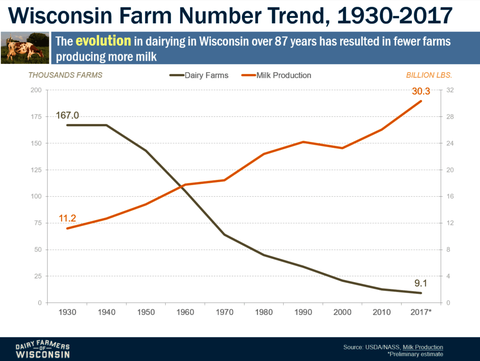It is not a secret that milk prices have not been great for the last four years. Minnesota lost about 10 percent of its dairy farms in 2018 alone. Wisconsin is down to about 8,000 farms.
The reduction in number of dairy farms is not a new trend. The Wisconsin Agricultural Statistics Service graph shows the decrease in number of farms since the 1930s with an associated increase in the total amount of milk produced in the state. But the reduction has been more severe in 2018. Many farms have not been able to cover their cost of production and stay in business.
Trends in cost of production
Data from FINBIN show that the overall cost of production (including labor and management) averaged $17.22 per hundredweight (cwt) of milk in 2017.
The data show a linear trend by herd size. For herds with up to 50 cows, the cost was $20.22 per cwt compared to $16.70 for herds over 500 cows. Larger herds have economies of scale that most likely allow them to be more efficient and purchase products at a more discounted price.
A study we conducted with herd sizes greater than 2,500 cows (median herd size in the study was 3,957 cows) indicated that these herds had high labor efficiency, averaging 105 cows per full time employee, with the top 50 percent profitability herds averaging 122 cows (Evink and Endres, 2017). For comparison, on another study that included 67 randomly selected freestall dairy farms in Minnesota (Kloeckner and Endres, 2016) with average herd size of 633 cows (range of 176 to 2,063 cows) labor averaged 51.4 cows per full time employee.
However, there are smaller herds that have high milk production per cow and low cost of production. Feed costs represent 40 to 60 percent of the total cost of production, which is about 4 to 5 times the cost of labor, usually the second highest cost. The data from FINBIN show that feed cost averaged $7.86 per cwt of milk in 2017.
We found a somewhat similar number in our study with 67 farms at $7.18 per cwt. Therefore, it seems reasonable that doing what we can to optimize feed cost per cwt will make a difference in the bottom line and help herds continue to stay in business.
Factors that influence feed efficiency
Dairy production systems are very complex and include many moving parts. We need to pay attention to the basics and doing all the little things right too. It all adds up.
Focus on forage quality
Jim Linn used to teach us that forages are the base of the food pyramid. If the quality of the forage we feed our cows is not adequate, cows will not reach their milk production potential and we will have a higher cost of production per cwt.
Our study with 67 farms showed us that the type of corn hybrid used for silage production was associated with feed cost per cwt. Using only one type of corn hybrid — either silage or grain — and not switching from one type to another was associated with lower feed cost per cwt, maybe because of more uniformity in the silage offered to the cows. I think this finding could also be a marker for farms that were paying closer attention to forage quality.
Moisture content of wet forages should be measured frequently so that ration formulation can be adjusted if needed along with routine lab analysis for nutrient composition. It is important to reduce variation in nutrient content of the ration dry matter to provide cows a more consistent diet.
Feed bunk management and access to feed
In addition to high forage quality, optimal feed bunk management and access to feed are essential for our cows to be as productive as possible.
One of our studies with robotic milking farms (Salfer, Siewert and Endres, 2018) showed 11 pounds more milk per cow per day for herds using automatic feed push up compared to herds using manual feed push up. Most likely this difference would be less in conventional herds, but field observations have indicated increases of 3 to 5 pounds per cow with the more frequent feed push up. Old feed should be removed every day to prevent spoilage of new feed and encourage intake.
It is important to provide adequate feed bunk space for each cow, which is suggested to be 18 inches per cow in lactating cow pens and 30 inches per cow in dry and fresh cow pens. Another consideration is to aim for optimal feeding for refusals such that we do not have excess but also are not limiting intake.
Adequate particle size and dry matter of the ration will help reduce sorting. In addition, attention should be placed on ration mixing procedure and delivery.
It is important to evaluate forage quality, availability and cost of byproduct feeds, and feeding management on a routine basis to determine where costs can be reduced and feed utilization can be improved.
Cow comfort
Cow comfort or welfare should be as optimal as possible.
Research has shown that increasing resting time will increase milk production per cow, therefore reducing feed cost per cwt because cows are getting more out of the feed we provide them. Our studies have shown that herds with more comfortable, soft and appropriately designed stalls have better cow productivity.
Unrestricted access to clean water and having a good health care program in place are also essential for good cow welfare. Low stress cow handling has also been shown to improve cow performance and it doesn't cost anything. Just move cows slowly and quietly with care and respect.
All the basic little and big things can make a difference in your herd’s profitability at all times, but they're especially important during these tough times.


